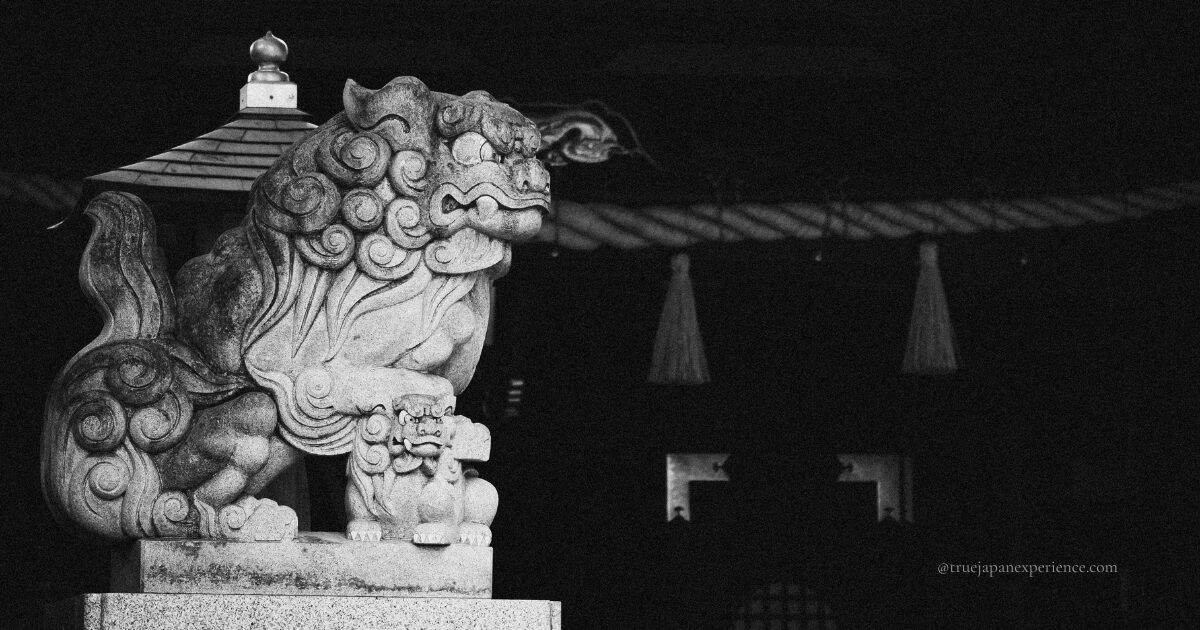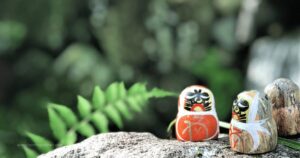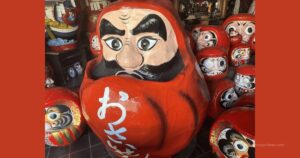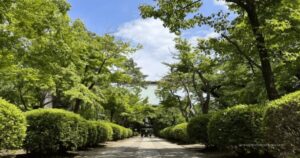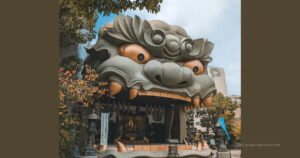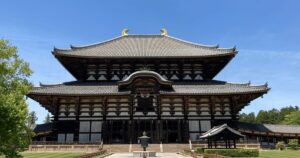Many visitors to Japan notice two stone statues at the entrances of shrines. These are called komainu statues. They guard the shrine and keep it safe from bad spirits.
This article explains the history and meaning of komainu statues. It also shows how to tell them apart and introduces rare types. At the end, it compares komainu statues with fox statues found at Inari shrines.
The Origin and Background of Komainu Statues
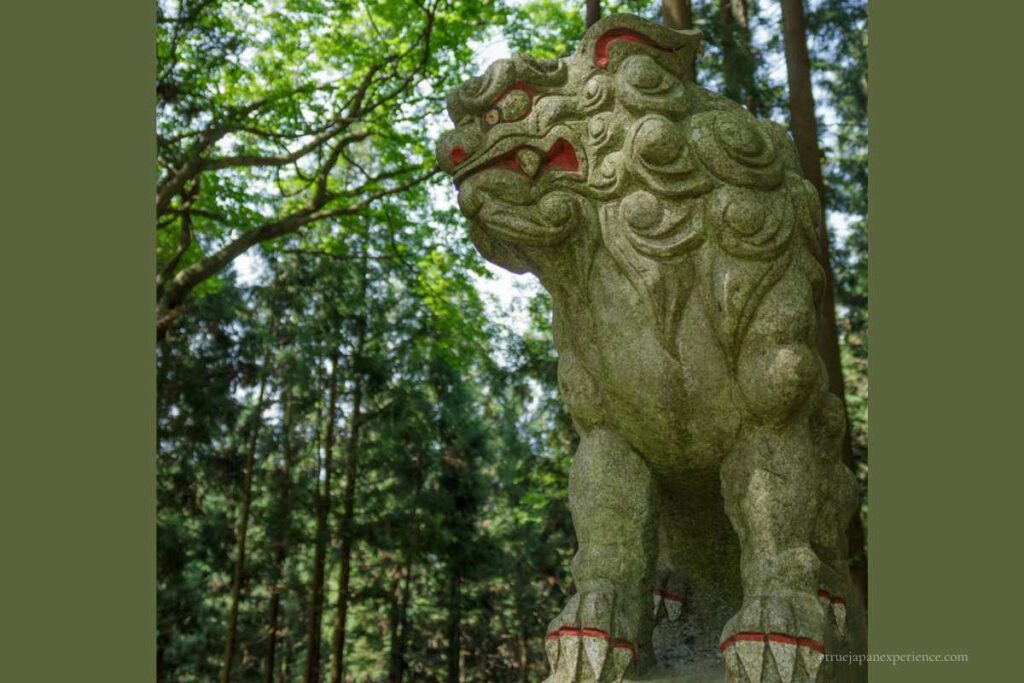
They protect the entrance of many Japanese shrines and have a long history that connects many different cultures.
From ancient lions in the Middle East to unique statues in Japan, the story of komainu shows how ideas travel and change over time.
Let’s begin by looking at the ancient origins of komainu statues far away in the Middle East and Egypt.
Ancient Origins in the Middle East and Egypt

Long ago, around 3000 BC, people believed lions were strong and powerful.
In ancient Mesopotamia (the area near the Tigris and Euphrates Rivers), carvings showed brave hunters fighting lions. Lions stood for strength and protection.
In ancient Egypt, huge statues called sphinxes had lion bodies with human faces. These sphinxes guarded important places like temples and tombs.
People in these ancient lands used lion statues to show power and to keep evil away.
The Spread of Lion Guardians to China

The idea of using lion statues as protectors traveled from the Middle East to China.
In China, lion statues became famous and were called “shishi” or guardian lions. They protected palaces, temples, and cities.
Ancient China created many kinds of spiritual beasts. Some of these were strange creatures that had one horn or looked unlike real animals.
These mythical beasts became models for the guardian statues, including those that influenced Japanese komainu.
Arrival and Transformation in Japan
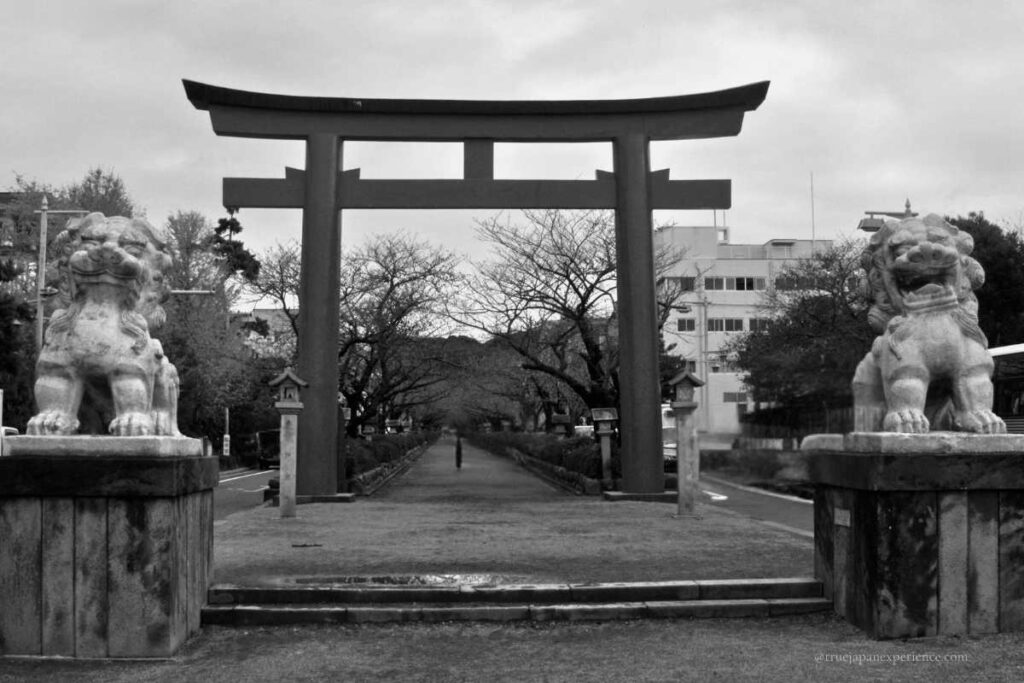
The idea of guardian lion statues came to Japan through China and Korea.
At first, Japan used wooden lion statues inside palaces.
During the Nara period (710–794 AD), the statues were mostly indoors and looked like lions.
Later, in the Heian period (794–1185 AD), the statues began to appear outside temples and shrines.
That’s when the statues started to take on the form we now call “komainu”.
The Role and Meaning of Komainu Statues
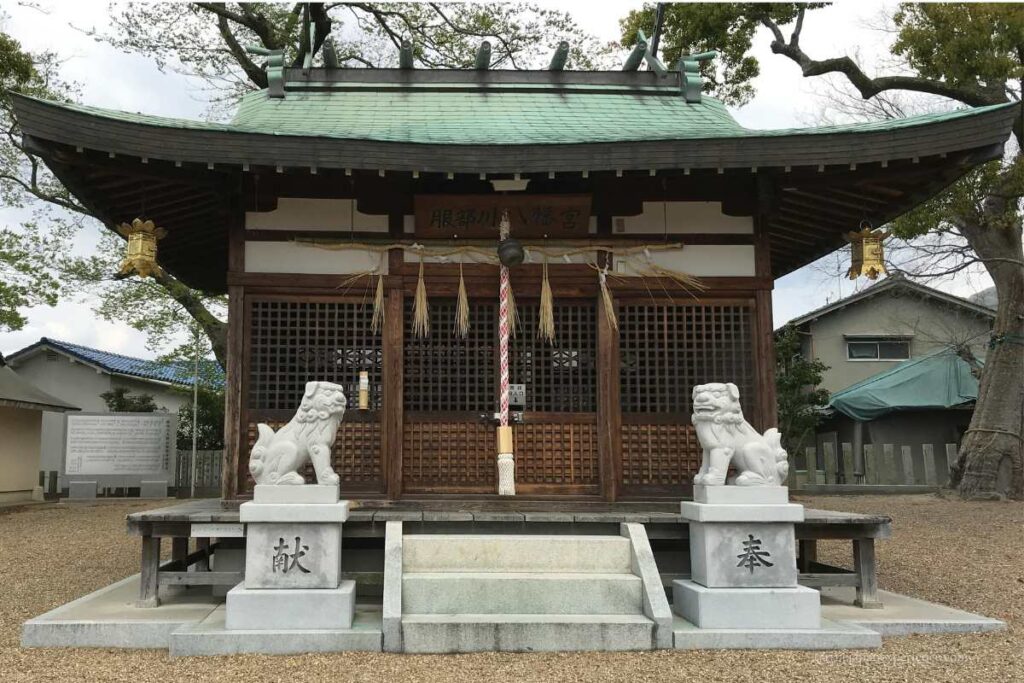
Komainu statues play an important role in Japan. They stand outside many shrines as guardians. Their job is to protect the sacred place from evil spirits and keep bad luck away.
Usually, komainu come in pairs.
One statue opens its mouth wide. This is called “a-gyo.” The other statue keeps its mouth closed. This is called “un-gyo.”
These mouth positions are very special. They show the beginning and the end of all things. In Japanese and Buddhist belief, “A” is the first sound and “Un” is the last sound.
During the Heian period (about 1,000 years ago), the statues started to have unique Japanese features.
One important change was that they made the pair look different: the right statue had its mouth open like a lion, and the left statue had its mouth closed and sometimes a horn on its head.
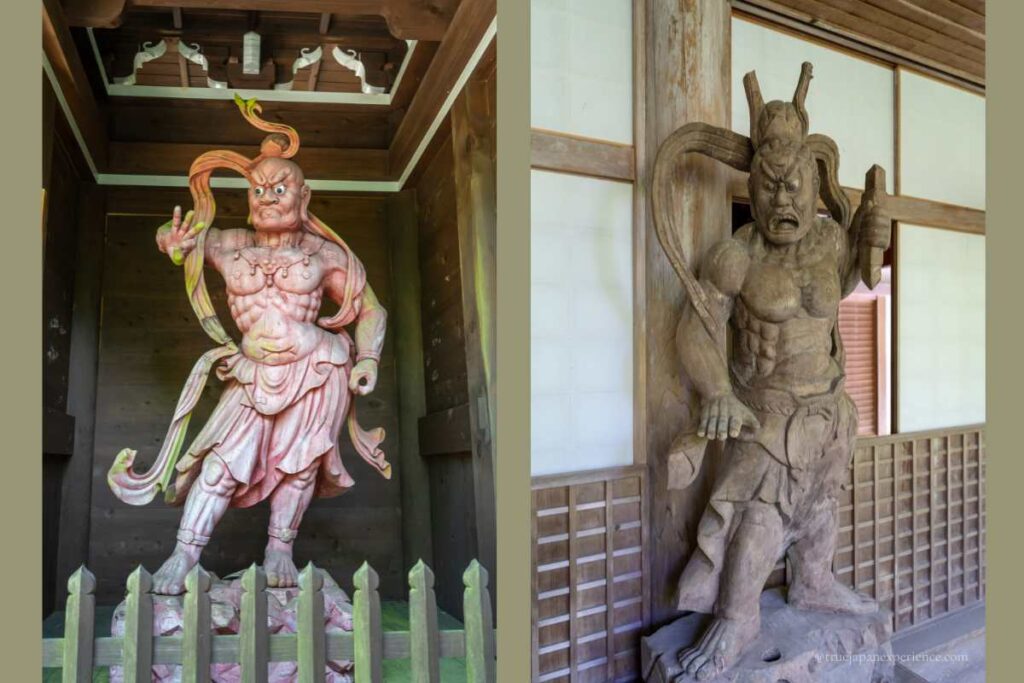
This shape was inspired by other Japanese guardian statues called “Nio,” which stand at temple gates. This style used asymmetry (something being not the same on both sides), which was popular in Japan.
Over many years, komainu changed their shapes and styles. In different parts of Japan, they look a little different. Some komainu have fun or kind expressions. Others look fierce and strong.
In short, komainu are not just guardians brought from other countries. They grew in Japan to fit Japanese culture and beliefs.
The statues show Japan’s creative spirit and deep respect for protecting sacred places and people.
Komainu Statues and Fox Statues: What’s the Difference?

In Japan, you can often see animal statues at shrines. The most common are komainu statues and fox statues.
Komainu statues look like lions or dogs. They stand in pairs at the shrine gate. Their main role is to guard the shrine and keep away evil spirits.
Fox statues are quite different. They are the messengers of Inari, the god of rice and harvest. At Inari shrines, such as the famous Fushimi Inari in Kyoto, you will see many of them.
Other animals also act as messengers at certain shrines.
Wolves appear at mountain shrines like Mitake Shrine. Monkeys are found at Hie Shrine, also called Hiyoshi or Hiyama Shrine. Deer are the messengers at Kasuga Shrine.
Each animal connects to the shrine’s god and local traditions.
When we look at history within Japan, fox worship started earlier than the use of komainu. It began about 2,000 years ago in the Yayoi period and was linked to snake beliefs.
Komainu statues were introduced later from Chinese guardian lions. They became common in Japanese shrines mainly during the Heian period.
In short:
・Komainu statues are guardians that protect the shrine.
・Foxes and other animals are messengers that serve the gods.
Both play important but different roles in Japan’s shrine culture.
Unique guardian Komainu Statues
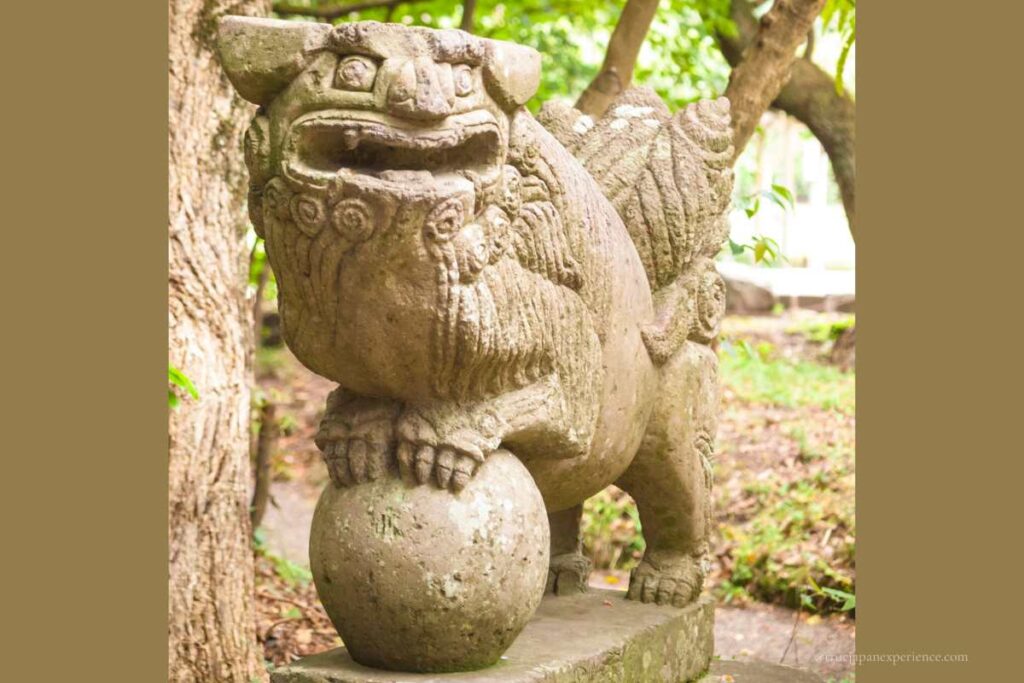
Lion statues came to Japan from China long ago. In Japan, they changed little by little and became the komainu we see today.
Now, you can find not only the common lion-dog style, but also many unique forms across the country.
In most shrines, you will see the usual pair of komainu. But in some shrines, the god’s messenger animal stands where the komainu usually are.
Here, we will look at some special and unusual komainu you can find in Japan.
Okazaki Shrine (Kyoto) – Rabbit Guardians

Okazaki Shrine in Kyoto is famous for its blessings of fertility, safe childbirth, health, and family harmony. Because of this, many people visit to pray for children and happiness at home.
Rabbits became a symbol of the shrine for two reasons. Long ago, wild rabbits lived in the area around the shrine. Also, the main gods worshiped here are a husband and wife, which connects to ideas of family and harmony. For these reasons, rabbits came to represent the shrine’s special power.
Today, rabbit statues serve as komainu, and many rabbit motifs can be found across the grounds. This soft and friendly image is very different from the strong lions or dogs that usually guard shrines.
Many people know Okazaki Shrine for its rabbit guardians. The shrine grounds also have many rabbit figures and motifs. You can see more of this rabbit-filled scenery in this Japanese blog: Kyoto’s “Cute Rabbit” Shrine – Okazaki Shrine (Usagi Shrine).
Otoyo Shrine (Kyoto) – Mouse Guardians

Otoyo Shrine in Kyoto is known as a place to pray for good health and long life. Many people visit to ask for protection from sickness.
Inside the shrine grounds, you will find a small sub-shrine called Daikoku-sha. In front of this sub-shrine stand two mouse statues instead of the usual lion-dogs.
This is because the god worshiped here, Okuninushi, is closely linked with mice in Japanese legends. In one story, a mouse saved his life.
One statue holds a ball, and the other carries a scroll. The ball is said to mean wisdom, while the scroll can mean learning.
The statues may look small and cute, but they play an important role in showing the shrine’s wish for health and safety.
You can find the shrine on Google Maps or visit the official website for more details.
Hitsuji Shrine (Nagoya) – Sheep Guardians

Hitsuji Shrine in Nagoya is known as a place to pray for family safety and good fortune. People also visit to ask for calm days and protection from trouble.
At this shrine, sheep take the role of guardians instead of the usual lion-dogs. The word hitsuji means “sheep” in Japanese, and the shrine’s name itself comes from this animal. Sheep are linked with peace, gentleness, and the zodiac.
Here, the statues do not stand as a pair at the gate. Instead, they show a parent and child sheep sitting close together. This warm and friendly style is different from the strong and serious image of normal komainu. Many visitors feel a gentle and peaceful mood when they see them.
You can see more about the parent-and-child sheep guardians in this Japanese blog: Nagoya – Hitsuji Shrine with Parent-and-Child Sheep Guardians.
Munetada Shrine (Kyoto) – Upside-down Komainu
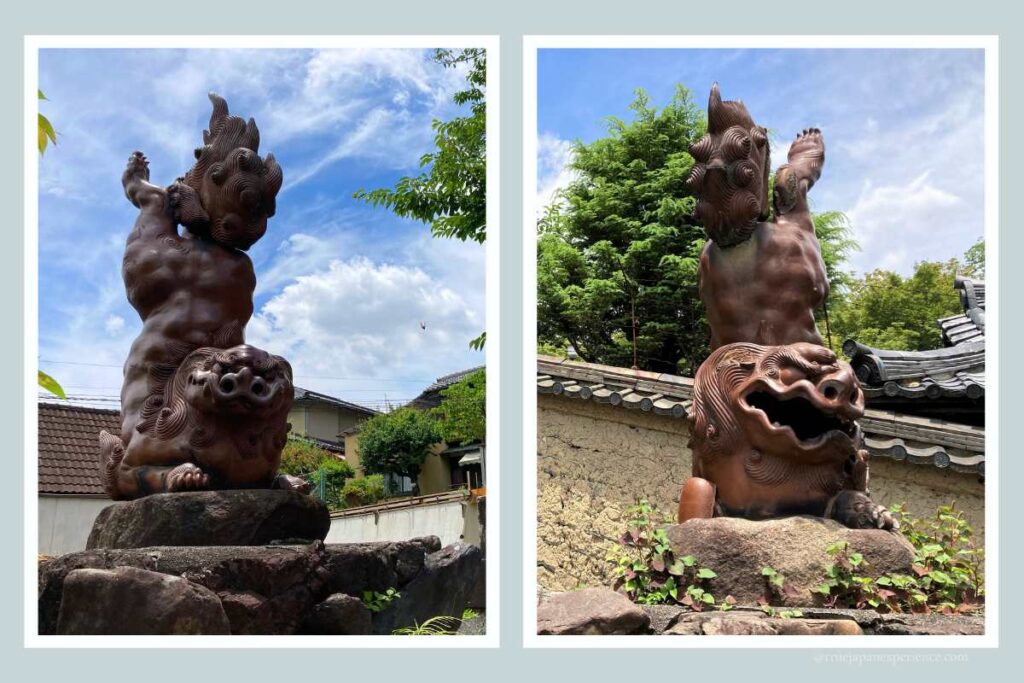
The last shrine we introduce is Munetada Shrine in Kyoto.
Here, you can see a very unusual komainu. This guardian stands upside down, and it is one of the rarest designs in Japan.
The statue uses Bizen pottery, a famous type of Japanese ceramic. The funny style is very different from the strong look of normal komainu.
Many visitors feel surprised when they see it, and they enjoy the shrine because of this unique guardian.
You can read more about Munetada Shrine and its unique atmosphere in this Japanese blog: Munetada Shrine on Mt. Yoshida in Kyoto.
Conclusion: The Many Faces of Komainu Statues
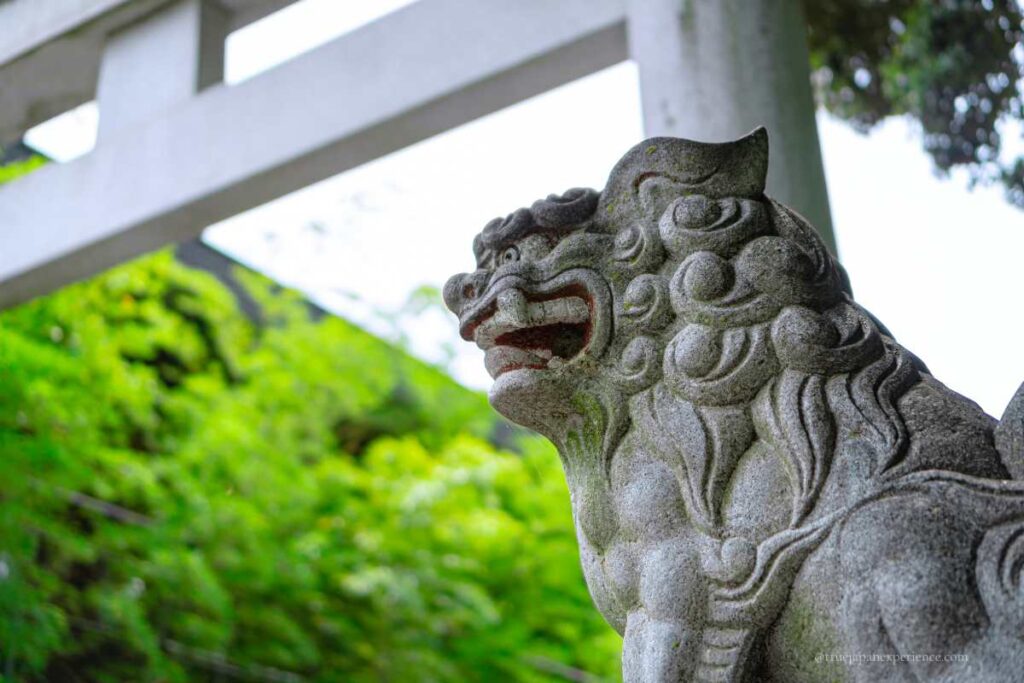
Komainu statues are much more than just stone animals at the gate.
Their long history brings together ideas from many cultures and shows the creative spirit of Japan.
Today, you can meet not only the classic lion-dogs, but also unique guardians like rabbits, mice, sheep, and even upside-down komainu.
Each statue offers a special meaning or feeling for visitors.
Komainu statues protect shrines, support good wishes, and add character to every visit.
When you see a komainu or animal guardian at a shrine, take a moment to enjoy its face, pose, and story.
Komainu statues often stand at the entrance of a shrine, just like torii gates. If you want to learn more about torii, take a look at this guide: Torii Gate Meaning: More Than Just Red Gates! Easy Guide to Colors, Shapes, and History of Torii.
